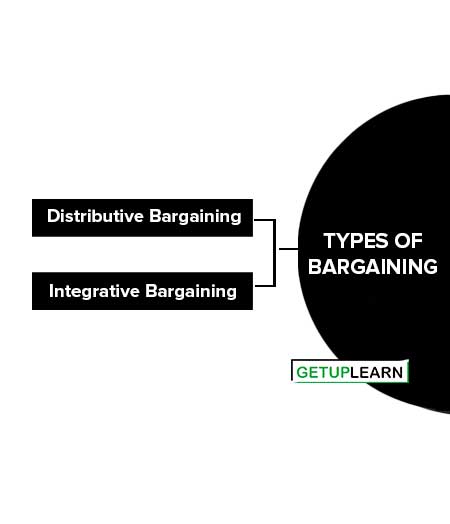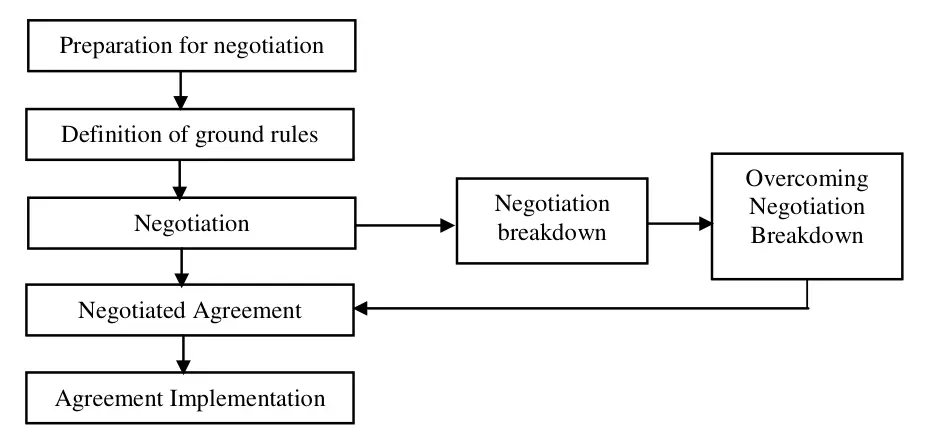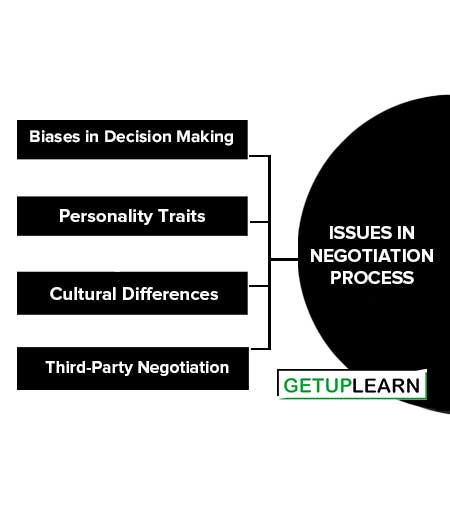Table of Contents
What is Negotiation?
Negotiation is a process in which two or more parties exchange goods or services and attempt to agree on the exchange rate for them.
Compromise is a well-accepted technique for resolving conflicts. This compromise is arrived at through negotiation. Therefore, understanding negotiation and how it works is important for conflict management. Negotiation basically involves bargaining. The dictionary meaning of negotiation is bargaining for the purpose of mutual agreement.
In other’s words, Negotiation is the process in which two or more parties (individuals or groups) attempt to reach an agreement on issues on which they have differences.
Types of Bargaining
It may be seen that negotiation is an attempt to settle differences among parties; it is not necessary that the differences are actually settled. In negotiations, two types of bargaining may be involved:

Distributive Bargaining
Distributive bargaining operates under zero-sum conditions, that is, any gain to one party is at the expense of the other party. Normally, in distributive bargaining, various economic issues are involved, such as wages, salaries, bonuses, and other financial matters.
While bargaining with each other, each party has a target point that defines what it would like to achieve. Each party also has a resistance point which marks the lowest outcome that is acceptable point below which the parties would break off negotiation rather than accept a less-favorable settlement.
The area between these two pints makes up each one’s aspiration range. While engaged in negotiation, each party’s tactic is to get its opponent to agree to one’s target point or to get as close to it as possible.
Integrative Bargaining
In contrast to distributive bargaining, integrative bargaining operates under the assumption that there exists one or more settlements that can create a win-win situation. Integrative bargaining is preferable to distributive bargaining because it builds long-term relationships and facilitates the table with a feeling that they have achieved victory.
In integrative bargaining, an attempt is made to understand the viewpoint of each party empathetically. As a result, many issues that are perceived to be controversial and are not likely to be resolved cordially do not appear to be so. However, integrative bargaining becomes effective when some conditions exist.
These parties must have sensitivity to each other’s needs, have the ability to trust others, and maintain flexibility. The below-given table below presents the comparative characteristics of distributive bargaining and integrative bargaining:
| Bargaining Characteristics | Distributive Bargaining | Integrative Bargaining |
| Available resources | Fixed amount of resources to be divided. | Variable amount of resources to be divided. |
| Primary motivation | I win- You lose. | I win- You win. |
| Primary interest | Opposed to each other. | Congruent with each other. |
| Focus of relationship | Short-term. | Long-term. |
Negotiation Process
Negotiation is a process that involves several steps as shown in the figure below:
- Preparation for Negotiation
- Definition of Ground Rules
- Negotiation
- Negotiated Agreement
- Agreement Implementation

Preparation for Negotiation
Preparation for negotiation is as important as the negotiation itself. Preparation for negotiation involves the following activities:
- Collection of information about the nature of conflict requiring negotiation, its history, and causes to understand the conflict from the right perspective.
- Understanding of the perception of the other party about the conflict and its likely effect on both parties.
- Determination of the target point as well as resistance point for the outcome of the negotiation.
Definition of Ground Rules
Once the preparation for negotiation is completed, ground rules for negotiation are framed out in consultation with the other party to the negotiation. Ground rules include the following aspects:
- Who will do the negotiating?
- Where will the negotiation take place?
- What time constraints, if any, will apply?
- To what issues will negotiation be limited?
- Will there be a specific procedure to follow if any impasse is created?
Negotiation
At this stage, both parties engage in negotiating with each other at a time and place fixed for the purpose. At the negotiating table, both parties explain, clarify, and justify the original proposals. Based on this, the actual process of give and take starts.
For this purpose, one of two approaches can be adopted: The piecemeal approach and the total approach. In the Piecemeal approach, an issue can be taken, deliberated, and decided without linking it to another. In this way, all issues are decided.
In order for the negotiation proceeds smoothly, the items first taken are those on which consensus is expected without much discussion, leaving the more contentious issues to be settled at the end. In total approach, all the issues are discussed but issue-wise decision is not arrived at as no issue is settled independently. Every issue is kept open until the whole negotiation process is ready to fall into place into a total agreement.
Negotiated Agreement
When both parties arrive at some mutually- acceptable agreement at the initial negotiation or through overcoming a negotiation impasse, the agreement is entered into between the parties. In certain cases, there is a need for ratification of the agreement, for example, in the case of a labor union-management agreement; ratification is required by the union and management.
Agreement Implementation
When the agreement is finalized, it becomes operational from the date indicated in the agreement. The agreement must be implemented in terms of its letters and spirit by both parties.
During the process of agreement implementation, there is a possibility that some provisions may create problems in the organization because of poor drafting of provisions.
If a mechanism has been provided in the agreement itself, this problem can be overcome through this mechanism. Where no such mechanism is provided, it can be sorted out through mutual consultation between the parties concerned.
Issues in Negotiation Process
These are the issues in the negotiation process explain:

Biases in Decision Making
During the negotiation process, individuals might fall victim to biases on their part which results in ineffective decision-making. This also prevents them from arriving at a mutually acceptable agreement.
Personality Traits
Assuming that a negotiating strategy can be predicted by observing the personality traits of the opponent could prove to be a hindrance in effective negotiations.
However, studies have shown that the negotiation strategies as well as the outcomes of the negotiation process are unaffected by the personality traits of the members involved in the negotiation process.
Therefore, while preparing for the negotiation process, one would be better off focusing on the bargaining issues and the situational factors rather than on the opponent’s personality traits.
Cultural Differences
Cultural differences have an impact on the negotiation process. For instance, negotiation styles differ from country to country. The Japanese and the Chinese, for example, tend to prolong the discussions, giving importance to minute details. In stark contrast, North Americans give importance to time and deadlines and try to end the discussion as soon as possible.
Third-Party Negotiation
In the event that the results of direct negotiations fail to satisfy both parties, they appoint a third-party negotiator to arrive at an agreement that is acceptable to both parties. The third-party negotiator could be:
-
A Mediator: A mediator uses logical reasoning and persuasion techniques to convince parties to arrive at an agreement. S/he also suggests alternative solutions that could prove beneficial to the conflicting parties.
-
An Arbitrator: An arbitrator is sometimes appointed voluntarily by the parties and in some cases by the law. S/he has the authority to enforce her/his decision over the conflicting parties.
-
A Conciliator: A conciliator is a third-party negotiator who tries to act as an informal link between both parties. S/he is also trusted by both parties and tries to come up with a solution that is acceptable to both sides.
- A Consultant: A consultant uses conflict management techniques to resolve the differences between the parties. However, he does not find any specific solutions, but only helps both the parties in finding a solution.
FAQs Section
What are the types of bargaining?
These are the two major types of bargaining:
1. Distributive Bargaining
2. Integrative Bargaining.
What is the negotiation process?
The following are the steps of the negotiation process:
1. Preparation for Negotiation
2. Definition of Ground Rules
3. Negotiation
4. Negotiated Agreement
5. Agreement Implementation.
What are the issues in the negotiation process?
These are some issues in the negotiation process:
1. Biases in Decision Making
2. Personality Traits
3. Cultural Differences
4. Third-Party Negotiation.
